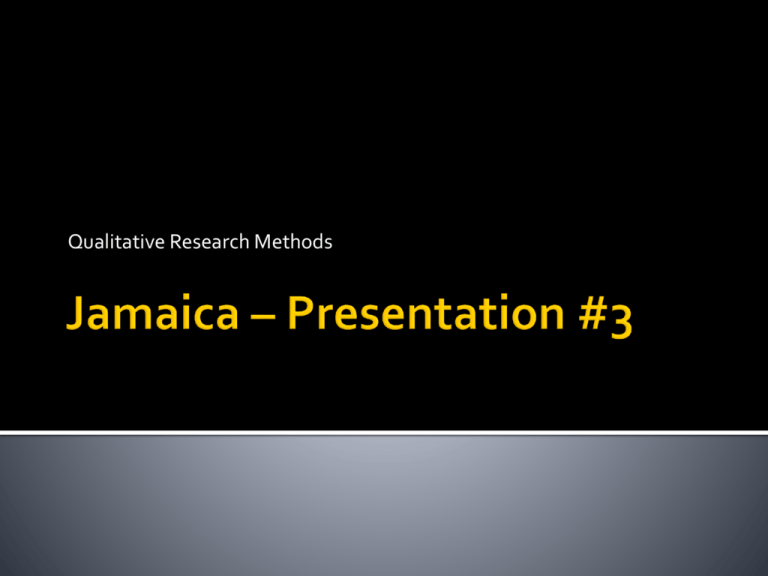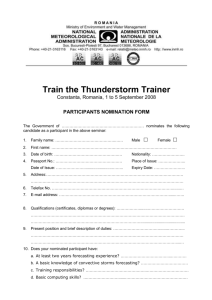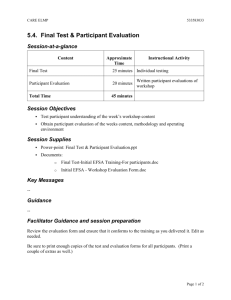Jamaica * Presentation #3
advertisement

Qualitative Research Methods Participant observation is appropriate for collecting data on naturally occurring behaviors in their usual contexts. In-depth interviews are optimal for collecting data on individuals’ personal histories, perspectives, and experiences, particularly when sensitive topics are being explored. Focus groups are effective in eliciting data on the cultural norms of a group and in generat- ing broad overviews of issues of concern to the cultural groups or subgroups represented. THESE DIFFER IN THAT: their analytical objectives the types of questions they pose the types of data collection instruments they use the forms of data they produce the degree of flexibility built into study design Participant observation is useful for gaining an under- standing of the physical, social, cultural, and economic contexts in which study participants live; the relationships among and between people, contexts, ideas, norms, and events; and people’s behaviors and activities – what they do, how frequently, and with whom. Through participant observation, researchers can also uncover factors important for a thorough understanding of the research problem but that were unknown when the study was designed. This is the great advan tage of the method because, although we may get truthful answers to the research questions we ask, we may not always ask the right questions. It is very time consuming, sometimes taking up a year in the field site collecting data. Not practical for most applied research methods. A second disadvantage of participant observation is the difficulty of documenting the data – it is hard to write down everything that is important while you are in the act of participating and observing. A third disadvantage of participant observation is that it is an inherently subjective exercise, whereas research requires objectivity. The immature rice stalk stands erect, while the mature stalk, heavy with grain, bends over. —Cambodian proverb Indirect/ high context: Refers to the unconscious and innate understanding of a person. they and the other person will behave in a particular situation. Because people in high context cultures already know and understand each other quite well, they have evolved a more indirect style of communication. They have less need to be explicit and rely less on words to convey meaning—and especially on the literal meaning of the spoken word— and more on nonverbal communication. Low context cultures, like the United States, tend to be more heterogeneous and individualist and accordingly have evolved a more direct communication style. Less can be assumed about the other person in a heterogeneous society, and less is known about others in a culture where people prefer independence, self- reliance, and a greater emotional distance from each other. The United States in unique in its’ communication style- we communicate to get or give information. The importance of “face” differs in every culture. Some prefer to see your face (U.S.) while other countries like the middle east cover faces and heads. It is okay to confront and say no. Nonverbal communication (gestures) vary depending on the country. I learned that I am a very non-confrontational person after reading these passages! I also learned that I would be interested in learning more about other countries non-verbal communication skills! In the cross cultural dialogue: An American teacher goes to teach students in West Africa. There are two accounts; one of the students and one of the teacher. They vary completely. It is interesting looking at the contrast! As Americans, we think we can pretty much do whatever we set our minds to. In Romania, things operate more [cautiously]. There is a great fear of risk. —PCV Romania The Yapese concepts of time, work, and plan are radically different from ours. Yapese time means an hour or two later; work is a mixture of performing the task and getting updated on everyone from the coconut wireless; plan is a general discussion of something to be done without the details, the doers, the tasks, or the timeline. PVC Micronesia What did I know? I wasn’t sure. And then it came to me: I knew how to get along with people. I knew how to bring people together. No, I didn’t know a great deal about gardening or almost anything technical, but I was sure I could bring together those who did with those who wanted to learn. -PVC Chile How can she understand our culture? She has only seen the rains fall once. —HCN Guineau-Bissau In the Jamaican classroom I would like to observe how the children to express themselves, show me a little about their culture, what type of music they listen to, how they interact inside class, and how they interact outside of class. Education starts at the tender age of 2 in Jamaica! This is called infant school. Infant school is from 3-5 years old. Next is kindergarten, and then first grade. First grade is referred to as primary school. Throughout the first 6 years, a series of tests are done in order to assess the children’s skills and abilities. Grade 1 Readiness Test Grade 3 Assessment Test in Mathematics and Language Arts Grade 4 Literacy Test Grade 6 Achievement Test in Mathematics, Language Arts, Science, Social Studies and Writing The Grade 6 Achievement Test, more popularly known as GSAT, is highly important because children are placed in High Schools depending on their performance on those exams. For most students, this is where they are introduced, for the first time to a foreign language. Some preparatory schools (at basic or primary level) introduce their students to Spanish and also to basic computer training. But Secondary education is the stepping stone and the foundation to students’ future career and further education. I would like to focus on: Spanish (foreign language) development Reading development Math skills Physical Education Areas (what they do in “gym class” Religious Education Family Health International (2005). Qualitative Research Methods: A Data Collector’s Field Guide Culture Matters Chapter 3 Culture Matters Chapter 4 Ministry of Education and Youth (2004) Simmons, D, Education in Jamaica.






